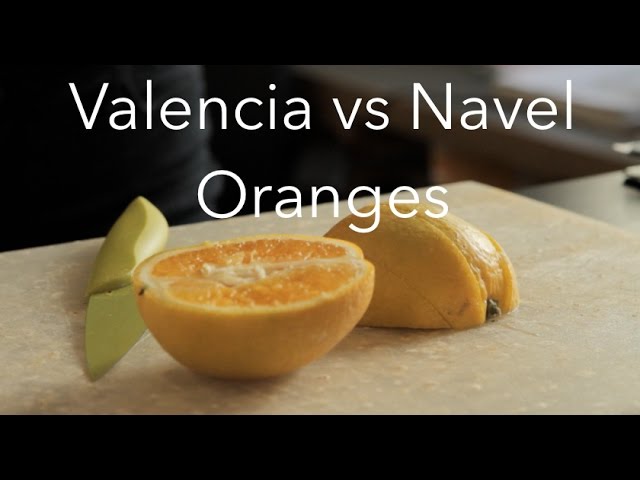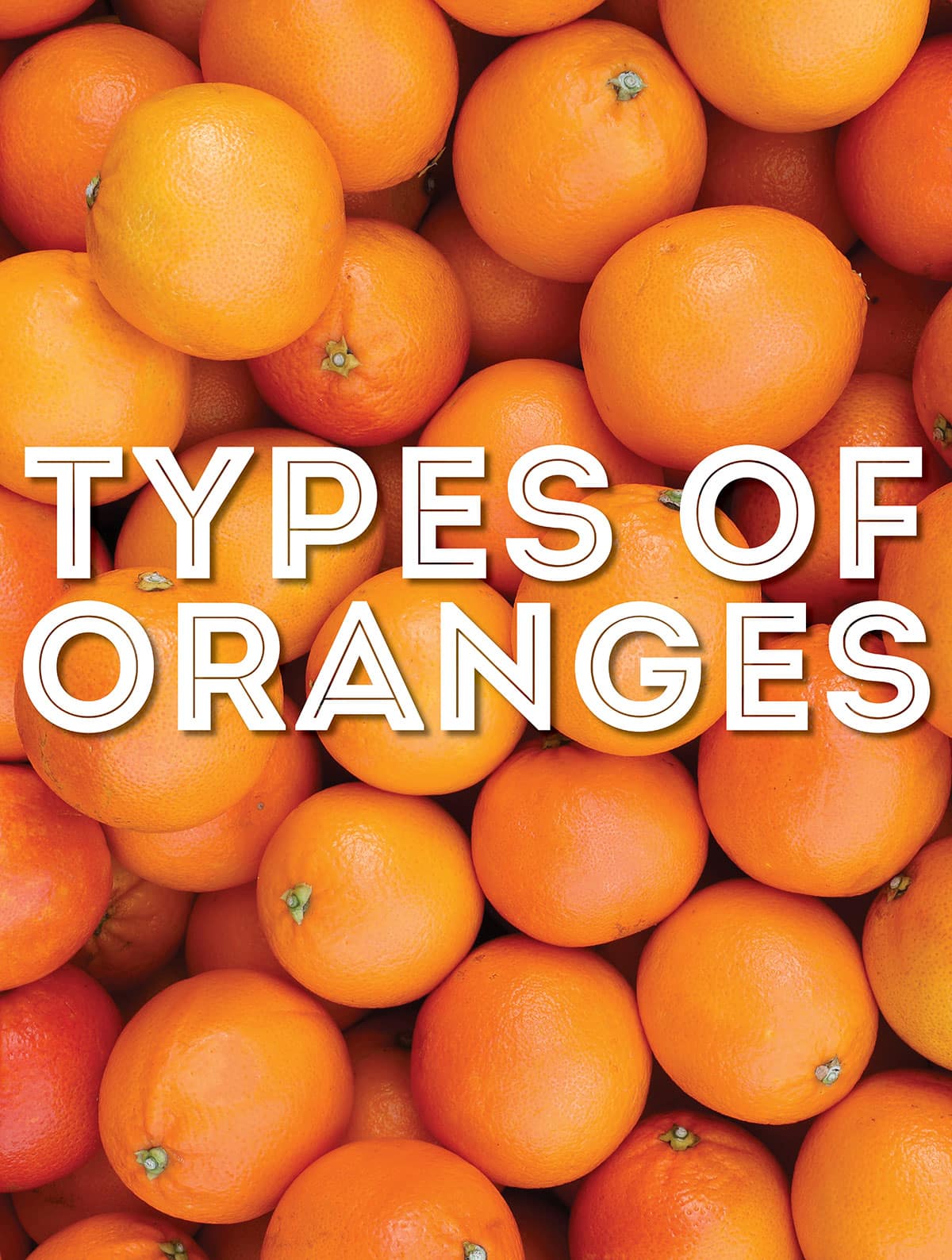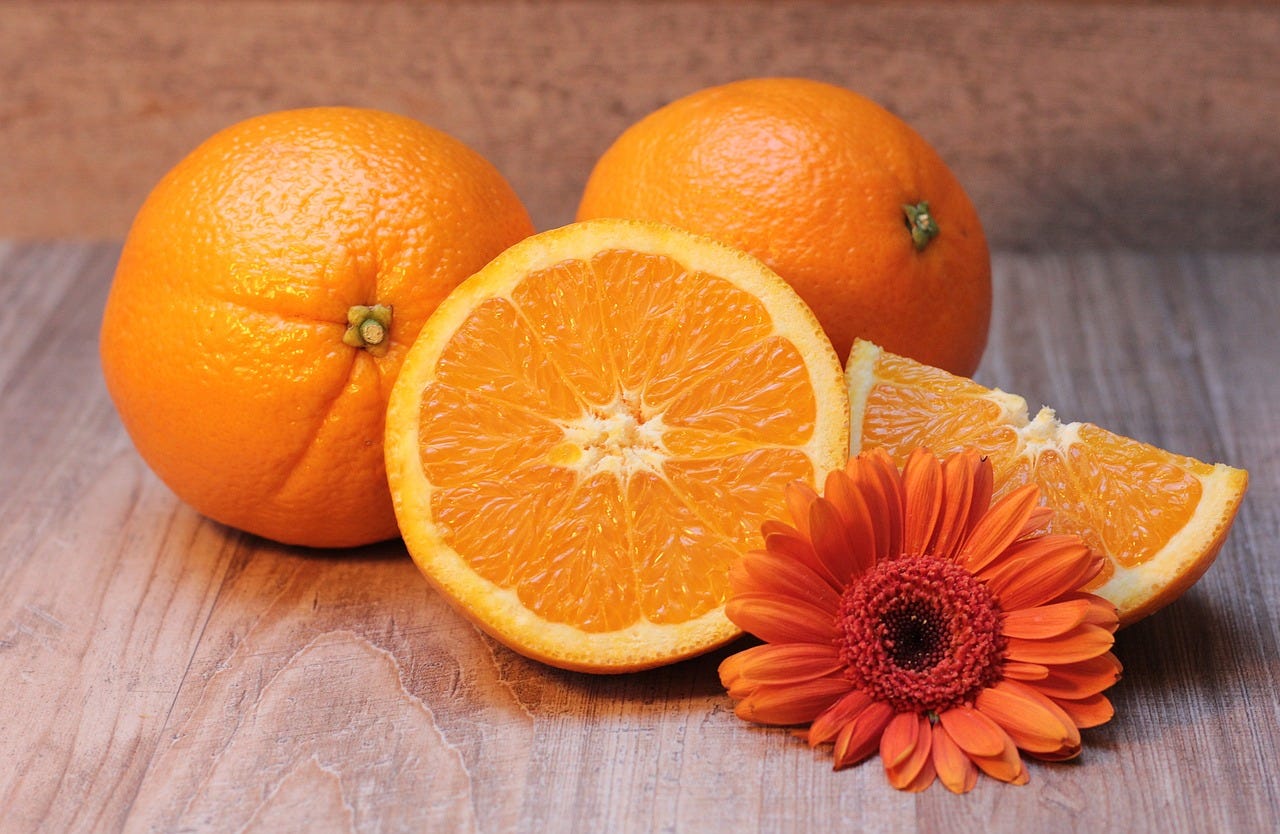Characteristics Of Valencia Oranges And Navel Oranges

Valencia Oranges are known for their sweet and tart taste, making them a popular choice for juicing. They have a bright orange color and a thin, smooth skin that is easy to peel. Valencia oranges are typically seedless or have very few seeds, making them convenient for eating or using in recipes.
On the other hand, Navel Oranges have a slightly sweeter flavor and a rich, vibrant orange color. They are larger in size compared to Valencia oranges and have a distinct “navel” at the blossom end. This navel is actually an underdeveloped second fruit, giving the orange its unique appearance.
Both varieties of oranges are juicy and refreshing, but Valencia oranges are often preferred for juicing purposes, while Navel oranges are enjoyed for their sweet flavor and easy-to-peel characteristics.
Valencia Oranges: Taste, Appearance, And Harvest Season
Valencia Oranges are known for their exceptional taste and vibrant appearance. With their sweet and tart flavor, they are a favorite choice for juicing. The bright orange color and thin, smooth skin make them visually appealing, while their juicy flesh provides a refreshing burst of citrus flavor. Harvested from March to September, Valencia Oranges are at their peak during the summer months. Their availability during this time makes them a popular fruit for enjoying fresh or incorporating into various recipes. So, whether you’re squeezing them for juice or enjoying them as a snack, Valencia Oranges are a delicious and nutritious choice.
Ii. Navel Oranges: Flavor Profile, Appearance, And Ideal Uses
Navel oranges are known for their sweet, juicy flavor and bright citrus aroma. They have a balanced sweetness with hints of tanginess, making them a delight to eat. Their appearance is characterized by a protruding navel-like formation at the blossom end, which gives them their name. The vibrant orange color, smooth texture, and easy-to-peel skin make them visually appealing. Navel oranges are great for snacking, as their seedless nature eliminates any interruptions to the juicy experience. They are also popular in salads, desserts, and as a garnish for cocktails, adding a burst of citrusy goodness to any dish. So whether you’re enjoying them fresh or incorporating them into your culinary creations, navel oranges are a versatile and delicious choice.
Nutritional Value And Health Benefits

Both Valencia oranges and navel oranges are packed with essential nutrients and offer a range of health benefits. They are excellent sources of vitamin C, which boosts the immune system, supports collagen production, and acts as a powerful antioxidant. Additionally, they provide dietary fiber, potassium, folate, and other vitamins and minerals essential for overall well-being. Consuming these oranges can help improve heart health, regulate blood pressure, support digestion, and promote healthy skin. Incorporating Valencia and navel oranges into your diet can be a delicious way to enhance your nutritional intake and support your health.
Valencia Oranges: Vitamin C Content And Health Benefits
Valencia oranges are known for their high vitamin C content, making them a powerhouse of immune-boosting benefits. With an average of 82% of the recommended daily intake of vitamin C in just one medium-sized orange, Valencia oranges help strengthen the immune system and protect against common illnesses. Vitamin C also plays a crucial role in collagen production, promoting healthy skin and wound healing. Moreover, this essential nutrient acts as a powerful antioxidant, protecting cells from damage caused by free radicals. Incorporating Valencia oranges into your diet can enhance your overall health and well-being.
Ii. Navel Oranges: Nutrient Profile And Potential Health Advantages
Navel oranges are not only delicious but also pack a powerful nutritional punch. They are an excellent source of vitamin C, providing about 93% of the recommended daily intake per medium-sized orange. This vital nutrient helps strengthen the immune system and promotes collagen production for healthy skin. Navel oranges also contain dietary fiber, which aids digestion and helps maintain a healthy weight. Additionally, they are rich in folate, a B vitamin essential for cell growth and development. The abundance of antioxidants found in navel oranges helps protect against chronic diseases and reduce inflammation. Including navel oranges in your diet can contribute to overall health and well-being.
Culinary Uses And Pairings

Valencia Oranges are incredibly versatile in the culinary world. Their sweet and tangy flavor makes them perfect for both sweet and savory dishes. They can be used in salads, sauces, marinades, and dressings to add a refreshing citrus kick. Valencia Oranges are also a popular choice for making freshly squeezed orange juice because of their high juice content. Additionally, they are widely used in baking, especially in cakes, tarts, and marmalades, as they add both flavor and moisture to the recipes. Pairing Valencia Oranges with ingredients like honey, ginger, cinnamon, and thyme can elevate the taste of your dishes.
On the other hand, Navel Oranges are often enjoyed on their own as a healthy snack. Their slightly sweeter and less acidic taste makes them perfectly suited for desserts. They can be used in a variety of desserts like fruit salads, fruit tarts, and sorbets. Navel Oranges can also be incorporated into savory dishes such as roasted chicken or pork dishes to add a citrusy twist. Their juice can be used as a marinade for seafood or in homemade salad dressings. Pairing Navel Oranges with ingredients like vanilla, chocolate, mint, and coconut can create delightful flavor combinations.
Both Valencia and Navel Oranges can enhance the flavor of cocktails and beverages. Their juice adds a refreshing and vibrant touch to drinks like margaritas, mimosas, and spritzers. Additionally, they can be used as garnishes to add a burst of color and flavor to cocktails.
Overall, both varieties of oranges offer endless culinary possibilities, so get creative in the kitchen and explore the delicious flavors that Valencia and Navel Oranges have to offer.
Valencia Oranges In Recipes And Cooking
Valencia Oranges are highly prized in the culinary world for their versatile flavor profile. Their sweet and tangy taste makes them perfect for a wide range of recipes and cooking applications. When it comes to sweet dishes, Valencia Oranges can be used in cakes, tarts, and marmalades, adding both a burst of citrus flavor and a touch of moisture. In savory dishes, their refreshing citrus kick pairs well with salads, sauces, marinades, and dressings. Their high juice content also makes them ideal for freshly squeezed orange juice, perfect for breakfast or as a base for cocktails. Get creative in the kitchen and explore the endless possibilities that Valencia Oranges offer in your recipes.
Ii. Navel Oranges In Desserts And Culinary Pairings
Navel Oranges are not only delicious on their own but can also add a burst of citrus flavor to a variety of desserts and culinary creations. Their sweet and slightly tangy taste pairs well with creamy desserts like custards, puddings, and ice creams. Navel Orange segments can be added to fruit salads, used as a topping for cakes or tarts, or transformed into a refreshing sorbet. The bright flavor of Navel Oranges also complements savory dishes, such as roasted meats or grilled seafood, adding a touch of acidity and freshness. Explore the versatility of Navel Oranges in your culinary adventures and let their vibrant flavor shine.
Growing Conditions And Availability

Valencia oranges and Navel oranges have different growing conditions and availability.
Valencia oranges thrive in warm, subtropical climates and are primarily cultivated in regions such as California, Arizona, and Florida in the United States, as well as in Spain. They require plenty of sunlight and well-drained soil to flourish. The Valencia orange harvest season typically starts in late spring and continues through the summer months, making them readily available during that time.
On the other hand, Navel oranges prefer cooler, Mediterranean-like climates and are primarily grown in California, Arizona, and Texas in the United States, as well as in Australia and South Africa. They are usually harvested from late fall to early spring, making them more readily available during the winter months.
Both varieties can be found in grocery stores and farmers’ markets during their respective harvest seasons, ensuring that citrus lovers can enjoy their juicy goodness year-round.
Valencia Orange Cultivation And Regions
Valencia oranges are primarily cultivated in warm, subtropical regions such as California, Arizona, and Florida in the United States, as well as in Spain. They thrive in these areas due to their preference for plenty of sunlight and well-drained soil. These regions provide the ideal growing conditions for Valencia oranges, allowing them to develop their characteristic sweet and tangy flavor. The harvest season for Valencia oranges typically starts in late spring and continues through the summer months, making them readily available during this time. Their vibrant orange color and refreshing taste make them a popular choice for juicing and consumption.
Ii. Navel Orange Production And Availability
Navel oranges are widely cultivated in various regions around the world, including California, Florida, Spain, and Brazil. These oranges get their name from the small, navel-like formation at the blossom end of the fruit. The production of Navel oranges is typically high, making them easily accessible in grocery stores and farmers’ markets. With their popularity and demand, Navel oranges are available throughout the year, although they are most abundant during the winter months. Their sweet and juicy flavor, along with their vibrant orange color, makes them a favorite for both snacking and juicing. So, whether you’re looking to enjoy a fresh Navel orange on its own or incorporate it into a delicious recipe, these citrus gems are readily available for your culinary adventures.
Shelf Life And Storage Tips

Valencia Oranges and Navel Oranges both have a decent shelf life if stored properly. Valencia oranges can typically be stored for up to 2 weeks at room temperature before they start to lose their juiciness and flavor. For longer storage, it is recommended to refrigerate them, where they can last for up to 3 weeks. On the other hand, Navel oranges have a slightly shorter shelf life. They can be stored at room temperature for about a week, but to extend their freshness, it is best to refrigerate them, where they can last for up to 2 weeks.
To maximize the shelf life of both varieties, it is important to handle them with care. Store them in a cool and dry place, away from direct sunlight. Avoid storing them with other fruits that release ethylene gas, as this can accelerate the ripening process and shorten their shelf life. Additionally, make sure to inspect the oranges regularly and remove any damaged or moldy ones to prevent spoilage.
In summary, both Valencia oranges and Navel oranges can be stored for a reasonable amount of time if stored properly. Refrigeration is recommended for longer storage, and regular inspection is essential to maintain their freshness. Enjoy these delicious citrus fruits while they are at their peak flavor and juiciness!
Valencia Oranges: Storage Recommendations And Shelf Life
Valencia oranges can be stored for up to 2 weeks at room temperature before they start to lose their juiciness and flavor. For longer storage, it is best to refrigerate them, where they can last for up to 3 weeks. To maximize the shelf life of Valencia oranges, store them in a cool and dry place, away from direct sunlight. It is also important to inspect them regularly and remove any damaged or moldy ones to prevent spoilage. By following these storage recommendations, you can enjoy the delicious taste and freshness of Valencia oranges for a longer period.
Ii. Navel Oranges: Best Practices For Maintaining Freshness
To ensure the Navel oranges stay fresh and delicious for longer, proper storage practices are essential. Follow these best practices to maintain their freshness:
- Choose ripe and firm Navel oranges: Select Navel oranges that are heavy for their size and have a vibrant color, indicating freshness.
- Store in a cool and dry place: Keep Navel oranges in a well-ventilated area away from direct sunlight. Ideally, store them at a temperature between 40-50°F (4-10°C).
- Handle with care: Avoid dropping or bruising the Navel oranges, as this can accelerate spoilage.
- Inspect regularly: Check the oranges regularly for any signs of mold or decay. Remove any damaged fruits to prevent the spread of spoilage.
By following these best practices, you can optimize the shelf life of Navel oranges and enjoy their sweet and tangy flavor for a longer period.
Conclusion

In conclusion, the battle between Valencia oranges and Navel oranges showcases the diversity and deliciousness of citrus fruits. Both varieties offer unique flavors, nutritional benefits, and versatile uses in the kitchen. Whether you prefer the juicy and tangy taste of Valencia oranges or the sweet and seedless nature of Navel oranges, incorporating these fruits into your diet can provide a boost of vitamin C and other essential nutrients. So go ahead and explore the vibrant world of oranges, experiment with recipes, and enjoy the delightful clash of flavors in your fruit basket.
Comparison Of Valencia Oranges And Navel Oranges
When comparing Valencia oranges and Navel oranges, there are a few key differences to consider. The main distinction lies in their flavor profiles and uses. Valencia oranges are known for their tangy taste and are primarily used for juicing or making marmalades. On the other hand, Navel oranges have a sweeter and milder flavor, making them perfect for snacking or adding to salads. Additionally, Valencia oranges have a longer harvest season, typically from spring to summer, while Navel oranges are available during winter months. Ultimately, the choice between Valencia and Navel oranges depends on personal preference and intended use.
Recommendations For Usage And Purchasing Decisions
When it comes to choosing between Valencia oranges and Navel oranges, it ultimately depends on personal preference and intended use. If you enjoy tangy and tart flavors, opt for Valencia oranges, which are perfect for juicing or making marmalades. On the other hand, if you prefer a sweeter and milder taste, Navel oranges are ideal for snacking or adding to salads. When purchasing oranges, look for fruits that are firm, with smooth and vibrant skins. Avoid any oranges with soft spots, discoloration, or mold. Pick oranges that feel heavy for their size, as this indicates juiciness. With these recommendations in mind, you can confidently select the right oranges for your needs.
FAQ About Valencia Oranges Vs Navel Oranges: Citrus Clash In Your Fruit Basket
Q: What is the main difference between Valencia Oranges and Navel Oranges?
A: The main difference lies in their taste and appearance. Valencia Oranges are sweet and ideal for juicing, while Navel Oranges are seedless and have a slightly tangier taste.
Q: Which orange variety is better for juicing?
A: Valencia Oranges are known as the “juice orange” due to their high juice content, making them the preferred choice for juicing purposes.
Q: Are there any differences in vitamin content between Valencia and Navel Oranges?
A: Both varieties are excellent sources of vitamin C, but Valencia Oranges typically have a higher vitamin C content compared to Navel Oranges.
Q: Can Valencia Oranges and Navel Oranges be used interchangeably in recipes?
A: While both oranges can be used in various recipes, Valencia Oranges are more commonly used in recipes that require juicing, such as orange juice or salad dressings. Navel Oranges are often enjoyed fresh or in salads.
Q: Do Valencia Oranges and Navel Oranges have different harvesting seasons?
A: Yes, Valencia Oranges are generally harvested between March and July, while Navel Oranges are typically harvested between November and April. This difference in harvesting seasons allows for a longer availability of fresh oranges throughout the year.
Q: Which orange variety is better for snacking?
A: Navel Oranges are favored for snacking due to their sweet and seedless nature, making them convenient and enjoyable to eat on-the-go.
Q: Are Valencia Oranges or Navel Oranges more commonly grown worldwide?
A: Navel Oranges are more widely grown globally compared to Valencia Oranges, making them one of the most popular orange varieties consumed worldwide. Valencia Oranges are primarily grown in regions with a warmer climate suited for citrus production.

Duke City Kitchen, known for its fresh, simple, and delicious cuisine, has a rich history deeply rooted in the heart of the local food scene. Since its inception, Duke City Kitchen has been dedicated to providing an exceptional dining experience that celebrates the region’s flavors. Founded by a passionate group of food enthusiasts, Duke City Kitchen opened its doors with the vision of offering a welcoming space where people could gather to enjoy thoughtfully prepared meals made from the finest, locally sourced ingredients. This commitment to quality and community has been a driving force behind Duke City Kitchen’s success.